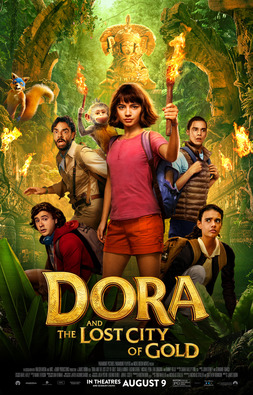Dora and the Lost City of Gold
Posted on August 8, 2019 at 5:48 pm
B| Lowest Recommended Age: | Kindergarten - 3rd Grade |
| MPAA Rating: | Rated PG for action and some impolite humor |
| Profanity: | Some schoolyard language ("freakin' awesome") |
| Alcohol/ Drugs: | Hallucinogenic pollen |
| Violence/ Scariness: | Extended action-style peril and violence, no one hurt |
| Diversity Issues: | Diverse characters |
| Date Released to Theaters: | August 8, 2019 |
| Date Released to DVD: | November 18, 2019 |

This is how Dora and the Lost City of Gold, the new live-action movie inspired by the animated series “Dora the Explorer” lets us know that its Dora, is a bit more grown-up than the Dora the Explorer we know from Nickelodeon. Following the prologue, a farewell dinner with Diego as he leaves for the United States, Dora is a 16-year-old (wide-eyed Isabella Moner, still rocking Dora’s headband and backpack, still the cheerful, curious, adventuresome girl with the monkey sidekick and the handy backpack. Her parents send her to stay with Diego’s family while they search for a legendary lost city filled with gold called Parapata.
Like Cady in “Mean Girls” and Mimi-Siku in “Jungle 2 Jungle,” Dora approaches her first experience in what some people think of as civilization as an amateur anthropologist. For Diego (Jeff Wahlberg), like many teenagers, feels like high school is “a horrible nightmare” and “a matter of life or death,” death, in his view, being noticed or embarrassed in any way. He tells Dora to be cool” and “keep a low profile.” He pleads with her, “For one day, stop being you.” “Is this to fit in with the indigenous people?” she asks.
Dora is not cool and she is incapable of keeping a low profile. In fact, the opposite of a low profile. She is seen as a threat by the school’s ambitious top student, Sammie (Madeleine Madden), the kind of girl who comes to a “come as a star” costume party as Justice Ruth Bader Ginsburg. Dora also befriends a picked-on science buff named Randy (Nicholas Combe), and she happily does a dorky dance at a school party.
On a school field trip to a natural history museum, Diego, Randy, Sammie, and Dora are teamed up for a scavenger hunt. As they look through the museum’s basement, they are kidnapped and flown to the jungle, where a bunch of bad guys want to use Dora to find her parents, and, through them, find the lost city of gold. Dora’s parents explain in the first scene in the movie that they are explorers, not treasure hunters. The bad guys are not about hunting treasure; they want to steal it. They are looters, not explorers. For Dora’s parents, “the discovery of new places is the treasure.”
The teens are rescued by Alejandro (Eugenio Derbez), who explains that he is a professor friend of Dora’s parents. The teens and Alejandro race toward the lost city, trying to get there before the bad guys, with many challenges, adventures, and “jungle puzzles” — and a hallucinogenic pollen-induced cartoon sequence — along the way.
As a junior-sized “Indiana Jones,” this movie does pretty well, with adventures pitched at the right level for the 7-14 crowd. The script, co-written by Nicholas Stoller (“The Muppets,” “The Five Year Engagement”) and Matthew Robinson (“Monster Trucks”) has a buoyant sense of fun and a heroine whose greatest act of courage may be the way she accepts herself and those around her.
There has been a bit of controversy about this film following a review that seemed confused about the idea of aging up the cartoon character, suggesting there was something wrong about her portrayal. But this Dora, charmingly played by Moner, is not supposed to be a hormonal teenager. She is a child’s aspirational vision of an older child, someone who has more knowledge, ability, independence, and strength. And it is great to have a movie about a teenager where the resolution does not depend on her being attractive to a boy. Which is not to say that there is no boy-girl emotion in the film; it just isn’t the point, which is just right for its audience. “Dora and the Lost City of Gold” is an exciting adventure with a boots-wearing monkey, a thief of a fox (watch for a funny PSA-style disclaimer at the beginning), and a heroine whose integrity, spirit, kindness, and curiosity about the world should inspire people of all ages.
Parents should know that this movie includes extended peril and mild action and violence (no one hurt), some potty humor, and some schoolyard language. The characters inhale some hallucinogenic pollen and there is a teen kiss.
Family discussion: Why doesn’t Dora follow Diego’s advice in school? Why does Sammie change her mind about Dora? What would you like to explore?
If you like this, try: the “Dora the Explorer” series and “Gold Diggers: The Secret of Bear Mountain”








